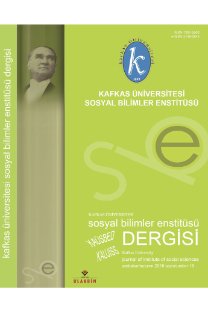STRUCTURAL ANALYSIS OF HANDLES OF HIGHLY CURVED IRANIAN SWORDS
Çok Kavisli İran Kılıçlarının Kabzalarının Yapısal Analizi
___
Aabdel-Salam, Z. & el-Sayed, A. (2014). Qualitative elemental analysis of farm animals' milk adopting laser spectroscopic technique, Indian Journal of Animal Sciences 84, (10): 1117–1120, October Issue.Allan, J. & Glimour, B. (2000). Persian steel: The Tanavoli collection. Oxford: Oxford University Press.
Evangelista, N. (1995). The encyclopedia of the sword. Santa Barbara: Greenwood. Khorasani, M. M. & Arjmandi, N. (To be published soon). Highly-curved Iranian swords: Structural properties and specifications.
Khorasani, M. M. (2006). Arms and armor from Iran: the Bronze age to the end of the Qajar period. Tübingen: Legat Verlag.
Khorasani, M. M. (2010). Lexicon of arms and armor from Iran: A Study of symbols and terminology. Tübingen: Legat Verlag.
Khorasani, M. M. (2018). Heirloom of steel: The collection of oriental and Asian arms and armor in Znojmo museum (The Czech republic). Znojmo: The Czech Republic.
Neshāt, S. M. (1989). Šomāš va megdār dar zabān-e Fārsi (Length and Weight Measurements in Persian). Tehran: Entešārāt-e Amir Kabir.
Toichkin, D. & Khorasani, M. M. (2016). Development of Karabela hilt on swords and sabers: A Comprehensive Study, Gladius, Vol. 36, pp. 181-194.
Turner, G. L. (2002). Dynamics of hand-held ımpact weapons. Association of Renaissance Martial Arts.
United States National Fish & Wildlife Forensics Laboratory (1999). Identification guide for ıvory and ıvory substitutes. Ashland, Oregon.
Xing He, Bo Su, Xingui Zhou, Junhe Yang, Bin Zhao, Xianying Wang, Gunagzhi Yang, Zhihong Tang & Hanxun Qiu (2010). Gelcasting of alumina ceramics using an egg white protein binder system, Ceramics-Silikáty, 55 (1), pp 1-7.
Yoshihara, Y., Kapp, L. & Hiroko Kapp (2012). The art of Japanese swords: The craft of sword making and its appreciation. Rutland: Tuttle Publishing.
Zeller, R. & Rohrer, E. F. (1955). Orientalische sammlung Henri MoserCharlottenfels:Beschreibender katalog der waffensammlung. Bern: Kommissionsverlag von K.J. Wyß Erben AG
- ISSN: 1307-5500
- Yayın Aralığı: 2
- Başlangıç: 2008
- Yayıncı: Kafkas üniversitesi Sosyal Bilimler Entitüsü
STRUCTURAL ANALYSIS OF HANDLES OF HIGHLY CURVED IRANIAN SWORDS
Manouchehr Moshtagh KHORASANI, Nima ARJMANDI
HAYALDEN MAZMUNA KLASİK TÜRK ŞİİRİNDE ‘PERDE’
ALÂEDDİN ÖZDENÖREN’DE GELECEK VE İNSAN İLİŞKİSİ
12 EYLÜL ARA REJİMİ DÖNEMİNDE TÜRKİYE’DE SİYASİ GELİŞMELER (1980-1983)
Yusuf Ziya KESKİN, Gülsemin AKIN
RELATIONSHIP BETWEEN PERSONALITY TRAITS AND VOCATIONAL INTERESTS: A LONGITUDINAL STUDY
Ufuk BARMANPEK, Catherine STEELE
HEART OF DARKNESS AND THE BEACH OF FALESÁ: PROMOTING OR SUBVERTING IMPERIALISM AND SOCIAL DARWINISM
AVUSTURYA’DA OSMANLI TARİHÇİLİĞİNİN PROFESYONEL BİR DİSİPLİNE DÖNÜŞÜM SÜRECİ
KARS’IN AHŞAP DESTEKLİ KÖY CAMİLERİ
